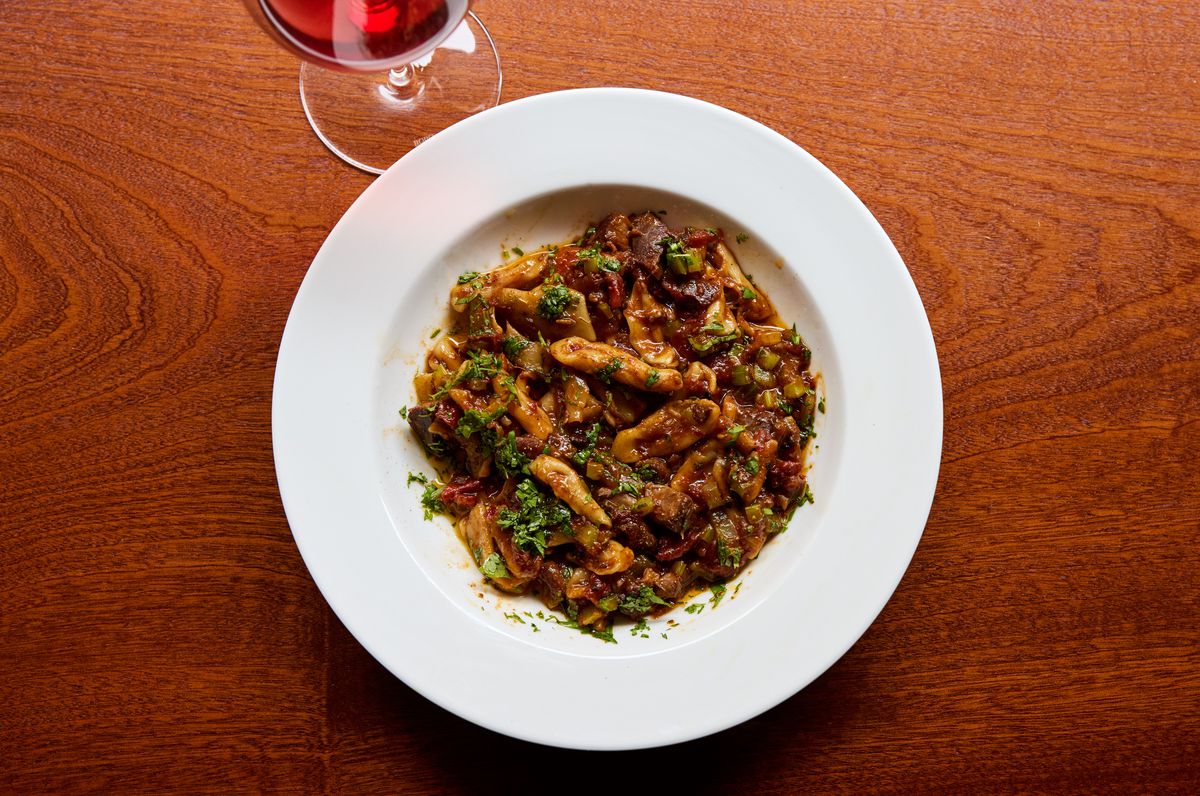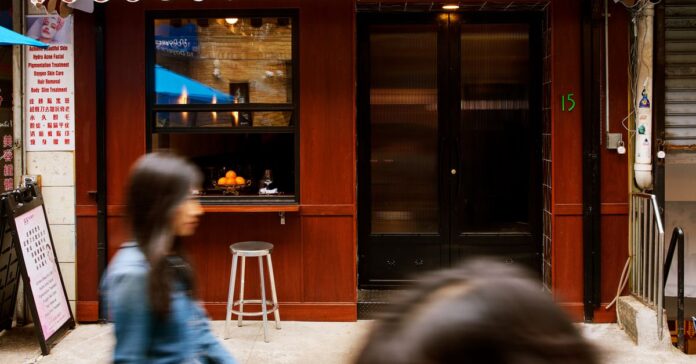Lei, a new wine bar, opens on Friday, June 6, on one of Chinatown’s most historic streets, at 15-17 Doyers Street, along a winding car-free stretch of the neighborhood. It joins a new wave of Asian American wine bars that opened within a mile of each other in Lower Manhattan over the past year, like Ha’s Snack Bar, a Vietnamese bistro, and Sunn’s, serving Korean small plates, expanding what today’s New York wine bars look and feel like.
“Doyer Street is just so iconic [and] historically significant,” says Lei’s owner Annie Shi. Much of the open real estate in Chinatown is passed through word of mouth; it took time to find the right spot. There were various points where she wasn’t sure she was going to be able to open a wine bar there, but she finally signed the lease in December 2024, just days out from her water breaking and giving birth. Across the board, Lei has been a labor of love; it’s named “as an homage to Shi’s late sister Hannah (Lei was her Chinese given name),” per the release.
Shi has made a name in New York for herself alongside Jess Shadbolt and Clare De Boer, partnering on King, in the West Village, and Jupiter, in Rockefeller Center, both with European-leaning menus. She’ll remain involved in both, but Lei is her independent endeavor (much like De Boer has with her spot Stissing House). Lei references a modern take on the Chinese cooking that the Rego Park, Queens native grew up with, interwoven with her years as a restaurant owner and beverage director — a project she’s been dreaming of for years.
In a slender storefront like this one, even the smallest design details must be considered. There’s no basement, so wine director and Heroes alum Matt Turner’s bottle storage had to be thoughtfully positioned. And there’s the all-electric kitchen: “Obviously, gas is incredibly important for wok cooking, but to be frank, there are so many better places that do wok cooking around us, that’s not going to happen here. So, okay, what else can we explore in Chinese cookery that is different?” she says of wanting to be considerate to the neighborhood. She added that she looked to wine bars in Paris, where they do so much with electric hookups, for some creative thinking.

“Steaming [and braising] is a big part of Chinese cooking that is suitable for wine because it’s a little bit more delicate, you retain a lot of the natural flavors of the ingredient,” she says.
For some, the electric set-up and small kitchen combo would be intimidating, but Lei’s chef Patty Lee, an alum of Mission Chinese, says: “I think the worst thing that can happen to you is having a blank canvas and staring at that. I feel more creative the more constraints there are.” The two spent a lot of time chatting through their collective dream menus.
It’s an edited list: There are fewer than 15 dishes on the menu, split into hot and cold sections. The hand-rolled cat’s ear noodles, which Shi describes as a less “rustic” version than what she grew up with, are tweaked to pair with wine and served with lamb braised in cumin and tomato. It’s the kind of place to find specials that might include items like three-cup fresh squid, a play on the Taiwanese three-cup chicken.
Lee also adapted a chrysanthemum salad recipe from her days running Kichin in Bushwick (which closed during the pandemic), on trend with other towering salads of late. “The dressing is 90 percent tea that’s been blended with vinegar — it feels like a bit more grown-up than the Vitasoy juice box.”

While they considered outsourcing, Lee is making the sesame bread, shaobing, from scratch, served with a pat of butter. “It’s so delicious and kind of unexpected,” says Shi.
Every wine bar needs its dessert: Lei will have two because Lee says she’s “such a sweets fiend.” To start, a guava shaved ice with pineapple guava, guava jelly, and tapioca; then there will be an eight treasure pudding with sticky toffee and vanilla ice cream. It’s a take on a dessert staple of Chinese New Year, that Shi says her dad is obsessed with to the point that he keeps a freezer stockpile. “Every family has a different version of what the eight treasures are. So it could be like black sugar, walnuts, or red bean,” Shi says.
Overall, the idea is for the 24-seat Lei to be a walk-in-friendly spot. “We really thought about what the difference is between a wine bar and a restaurant, and we wanted to make sure to keep that more casual feeling,” says Shi. There will be standing room at the intimate bar.
Chinatown has many celebratory BYOB spots, and Shi wants Lei to offer something “complementary.” She says, “the idea was you can totally have a meal if you want, but more importantly, if you are going to dinner somewhere in the neighborhood” — on just this block alone, there’s spots like Nom Wah Tea Parlor, Chinese Tuxedo, Taiwan Pork Chop House, and Tasty Hand-Pulled Noodles — “you can stop by for a glass of wine before or after your meal to kind of make it a full evening.”

